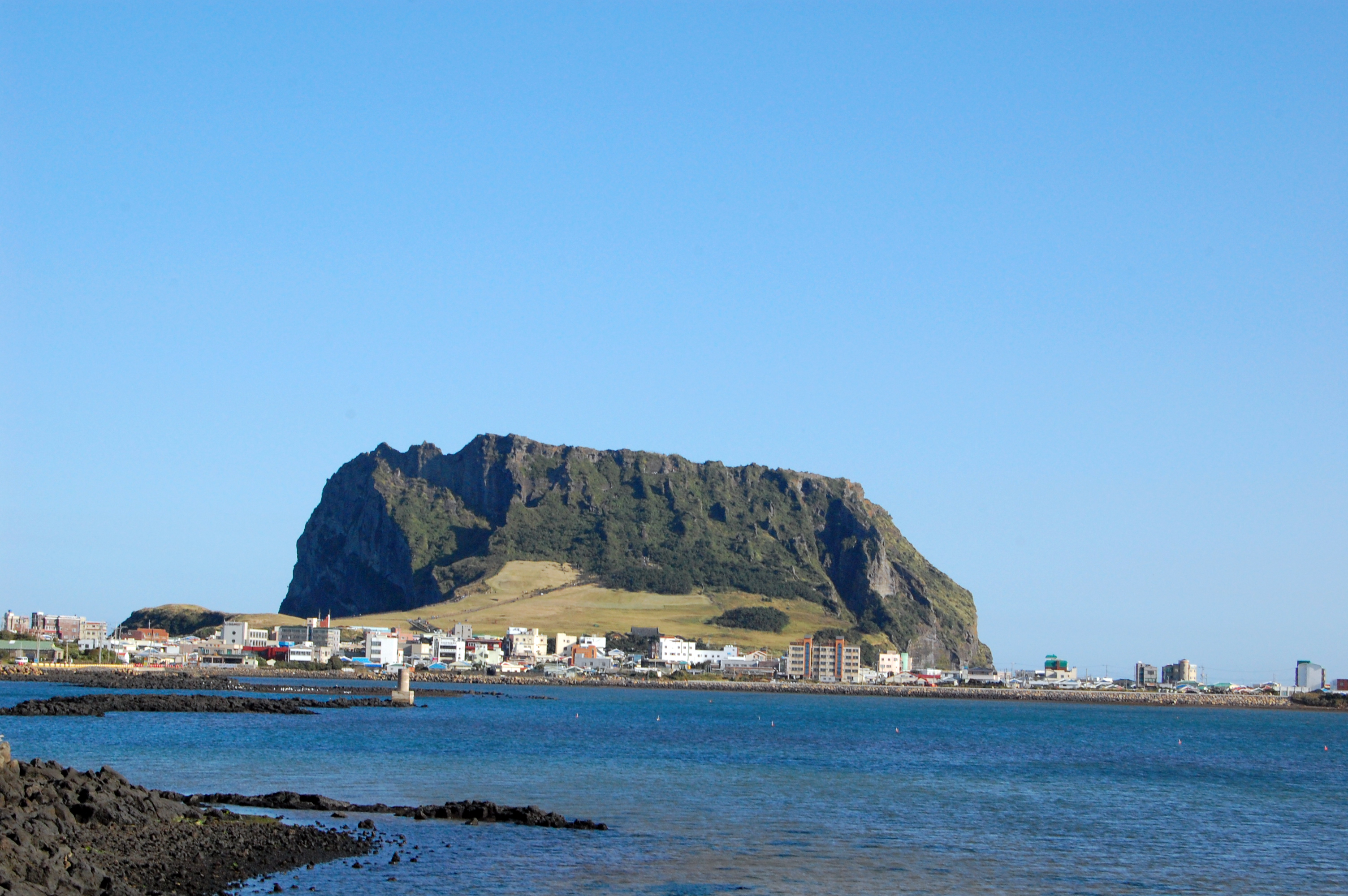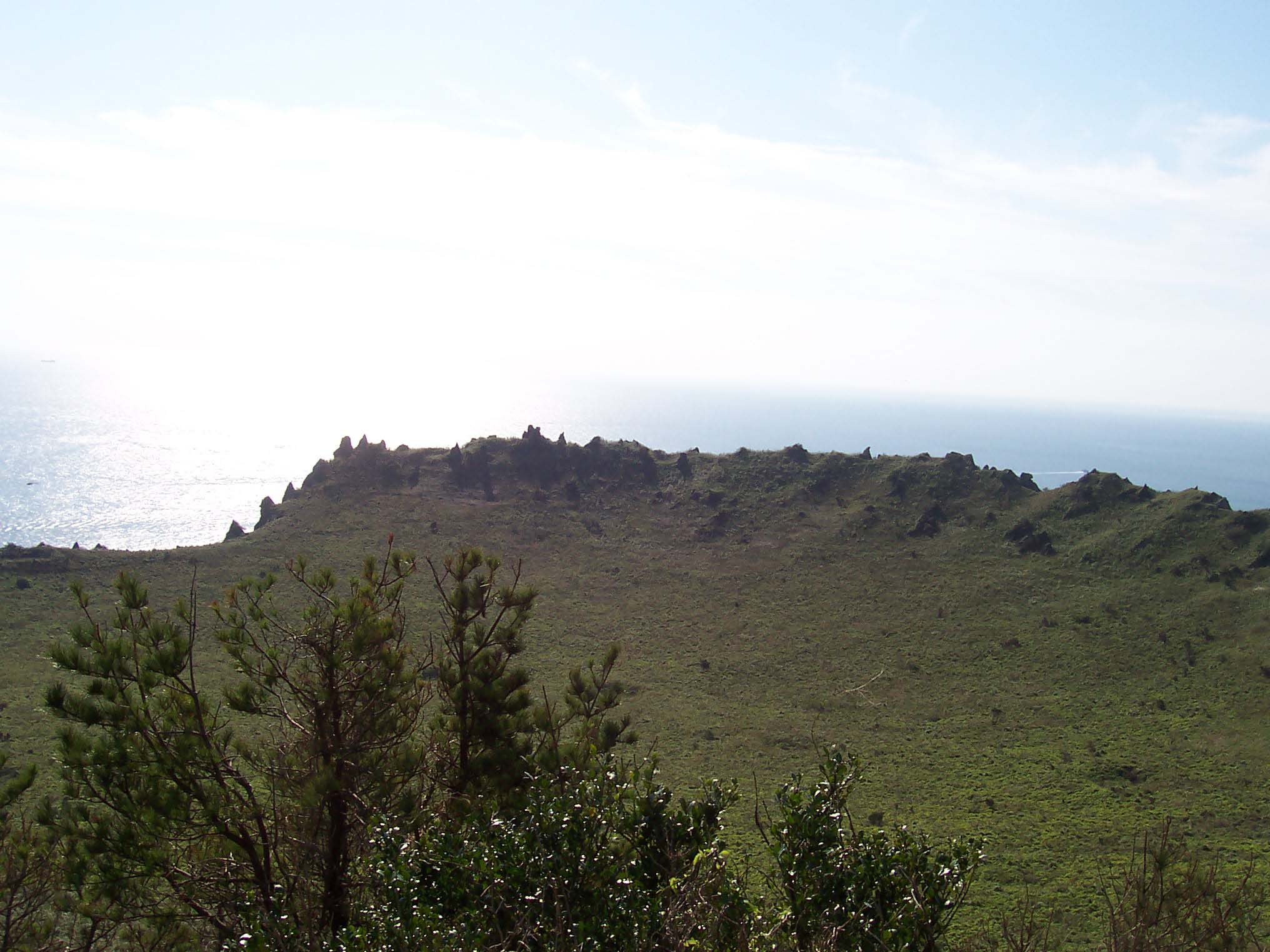Seongsan Ilchulbong on:
[Wikipedia]
[Google]
[Amazon]



 Seongsan Ilchulbong, also called ‘Sunrise Peak’, is an archetypal tuff cone formed by
Seongsan Ilchulbong, also called ‘Sunrise Peak’, is an archetypal tuff cone formed by
Jeju Special Self-Governing Provincial Tourism Association
* * * * * *
Jeju Volcanic Island and Lava Tubes, UNESCOJeju Special Self-Governing ProvinceJeju World Natural Heritage
{{coord, 33.4585, 126.9420, format=dms, type:landmark_region:KR, display=title Landforms of Jeju Province Tuff cones Volcanoes of South Korea



 Seongsan Ilchulbong, also called ‘Sunrise Peak’, is an archetypal tuff cone formed by
Seongsan Ilchulbong, also called ‘Sunrise Peak’, is an archetypal tuff cone formed by hydrovolcanic eruption
A phreatic eruption, also called a phreatic explosion, ultravulcanian eruption or steam-blast eruption, occurs when magma heats ground water or surface water. The extreme temperature of the magma (anywhere from ) causes near-instantaneous evapo ...
s upon a shallow seabed about 5 thousand years ago. Situated on the eastern seaboard of Jeju Island and said to resemble a gigantic ancient castle, this tuff cone is 182 meters high, has a preserved bowl-like crater and also displays diverse inner structures resulting from the sea cliff. These features are considered to be of geologic worth, providing information on eruptive and depositional processes of hydromagmatic volcanoes worldwide as well as past volcanic activity of Seongsan Ilchulbong itself.
Geological characteristics
Seongsan Ilchulbong Tuff Cone was formed by Surtseyan-type hydrovolcanic activity upon a shallow seabed about 5,000 years ago when the sea level was same as the present. Most volcanic cones or ''oreum''s (Jeju dialect
Jeju (Jeju: , ; ko, 제주어, or , ), often called Jejueo or Jejuan in English-language scholarship, is a Koreanic language traditionally spoken on Jeju Island, South Korea. While often classified as a divergent Jeju dialect ( ko, 제주방� ...
for volcanic cones) were formed by piles of scoria cones which are created by Hawaiian eruption
A Hawaiian eruption is a type of volcanic eruption where lava flows from the vent in a relatively gentle, low level eruption; it is so named because it is characteristic of Hawaiian volcanoes. Typically they are effusive eruptions, with basaltic ...
s or Strombolian eruptions. But Seongsan Ilchulbong Tuff Cone and a few other ''oreum''s on Jeju Island were hydromagmatic volcanoes which were made by piles of volcanic ash, the interaction of hot ascending magma and seawater or ground water. Seongsan Ilchulbong Tuff Cone is 182 meters high, and its crater is about 600 meters in diameter. It has a dip of strata
In geology and related fields, a stratum ( : strata) is a layer of rock or sediment characterized by certain lithologic properties or attributes that distinguish it from adjacent layers from which it is separated by visible surfaces known as ei ...
up to 45 degrees and is 90 meters from sea level to the crater floor.
Seongsan Ilchulbong Tuff Cone erupted in very moist and sticky conditions allowing a lot of water to permeate into the volcanic vent, making the diverse depositional features of a wet eruption. The wet hydrovolcanic activity continued until the end of the eruption. Consequently, the tuff has a bowl-like crater unfilled by scoria or lava.
Except for the northwestern park, the Seongsan Ilchulbong Tuff Cone forms a steep cliff because of the resultant wave following its eruptions. Through these eruptions, Seongsan Ilchulbong Tuff Cone shows a perfect cross section from the intracrater strata to the marginal strata. Its diverse geological structures are considered to have great geological importance because they may be used to interpret not only the past volcanic activity of the Seongsan Ilchulbong Tuff Cone but also eruptive and depositional processes of hydromagmatic volcanoes worldwide.
There are numerous hydromagmatic volcanoes similar to the Seongsan Ilchulbong, but there are no other known hydromagmatic volcanoes with a well-preserved tuff cone and diverse internal structures along a sea cliff. Because of these scientific values and remarkable scenery, Seongsan Ilchulbong Tuff Cone was able to be designated as a UNESCO World Natural Heritage site and it is worth preserving permanently as a natural heritage of humankind.
Natural ecosystem
The Seongsan Ilchulbong Tuff Cone's flora is composed of 222 taxa. There are 6 rare plant species: a fern, '' Crypsinus hastatus'', an orchid, ''Neofinetia falcata
''Vanda falcata'', the wind orchid, is a species of orchid found in China, Korea, and Japan. It was formerly classified in the genus ''Neofinetia''.
*风兰 (feng lan) China (N Fujian, S Gansu, SW Hubei, W Jiangxi, Sichuan, Zhejiang)
*풍란 (pun ...
'', two parasitic plants, ''Aeginetia indica
''Aeginetia indica'', commonly known as Indian broomrape or forest ghost flower, is a holoparasitic herb or root parasite of the plant family Orobanchaceae. It grows in moist deciduous and semi-evergreen forests of tropical and subtropical Asia a ...
'' and ''Orobanche coerulescens
''Orobanche'', commonly known as broomrape, is a genus of over 200 species of small parasitic herbaceous plants, mostly native to the temperate Northern Hemisphere. It is the type genus of the broomrape family Orobanchaceae.
Description
Broom ...
'', and two other herbaceous plants, '' Arisaema heterophyllum'' and ''Glehnia littoralis
''Glehnia'' is a genus of plants in the carrot family, Apiaceae. It is monotypic, being represented by the single species, ''Glehnia littoralis'', commonly known as beach silvertop and American silvertop. The genus was named after Russian botani ...
''. ''Aeginetia indica'' in particular is considered an important plant in terms of plant distribution, because in Korea it can be found only in Jeju Island, in the crater of Seongsan Ilchulbong Tuff Cone. There are additionally 300 species of marine algae on the Seongsan Ilchulbong Tuff Cone. Diverse new species were found in this area including '' Dasyiphonia chejuensis''.
Climbing
It takes usually one hour to climb to the top and to go down, using stairs, for an admission fee. The area is open from 7:10 am to 7 pm in summer and 7:30 am to 6 pm in winter. There is also a luggage storage room before the entrance.See also
*World Heritage Sites in South Korea
The United Nations Educational, Scientific and Cultural Organization (UNESCO) World Heritage Sites are places of importance to cultural or natural heritage as described in the UNESCO World Heritage Convention, established in 1972. Cultural heri ...
*Hallasan
Hallasan is a shield volcano on Jeju Island in South Korea; it is the highest point of South Korea and the second-highest mountain in Korea overall, after Paektu Mountain. The area around the mountain is a designated national park, the Hallas ...
*Gimnyeonggul
The Gimnyeonggul Lava Tube, located in Donggimnyeong-ri, Gujwa-eup, Jeju City, is one of the World Heritage Sites in South Korea.
The lava tube is about 705 m long, and is believed to be separated from Manjanggul Lava Tube by lava flows. The ...
*The Geomunoreum Lava Tube System
The Geomunoreum Lava Tube System is located between Seonheul-ri, Jocheon-eup and Weoljeong-ri, Gujwa-eup, Jeju City, Jeju-do. This lava tube system refers to a series of lava tubes formed while basaltic lava flow which had erupted several times ...
*Manjanggul
The Manjanggul Lava Tube is located in Gimnyeong-ri, Gujwaeup, Jeju City. At up to 23 metres (75') wide, 30 metres (100') high and 8.928 km (5½ miles) long, it is the 12th-longest lava tube in the worldhttp://www.caverbob.com/lava.htm and ...
References
Jeju Special Self-Governing Provincial Tourism Association
* * * * * *
External links
Jeju Volcanic Island and Lava Tubes, UNESCO
{{coord, 33.4585, 126.9420, format=dms, type:landmark_region:KR, display=title Landforms of Jeju Province Tuff cones Volcanoes of South Korea